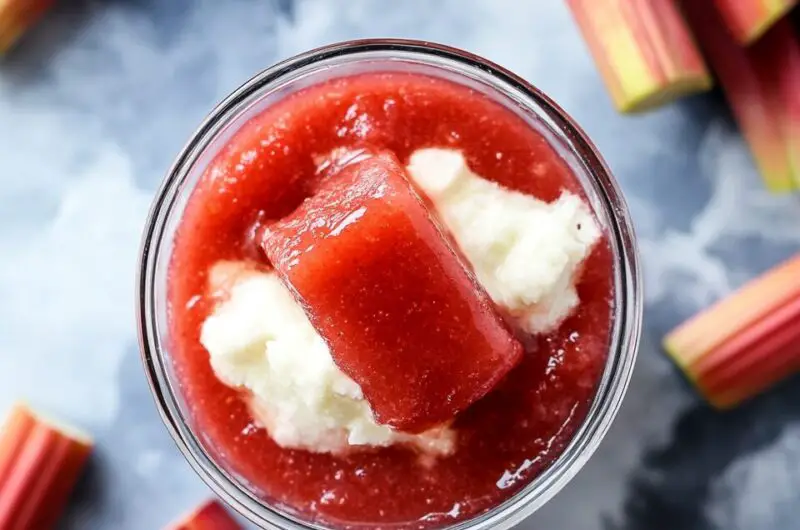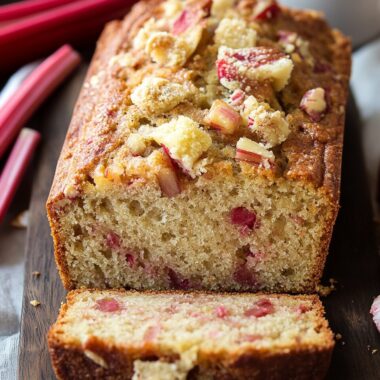This delightful Rhubarb Sauce captures the perfect balance of sweet and tart flavors, making it a versatile addition to your kitchen repertoire. Whether spooned over ice cream, drizzled on pancakes, or swirled into yogurt, it adds a burst of springtime freshness to every bite. With just a handful of ingredients and minimal effort, you’ll have a homemade treat that elevates any dish. Rhubarb is one of those seasonal gems that doesn’t stick around for long so when it’s in season, it’s time to make the most of it. This simple sauce lets the natural tanginess of rhubarb shine, mellowed by just the right touch of sugar and a hint of vanilla. It stores well in the fridge and can be frozen for later, making it a go-to condiment for desserts, breakfasts, or even savory pairings like pork or poultry.
Full Recipe:
Ingredients:
-
4 cups chopped rhubarb (fresh or frozen)
-
1/2 cup granulated sugar (adjust to taste)
-
1/4 cup water
-
1/2 teaspoon vanilla extract (optional)
Directions:
-
In a medium saucepan over medium heat, combine rhubarb, sugar, and water.
-
Stir gently and bring the mixture to a simmer.
-
Continue cooking for 15-20 minutes, stirring occasionally, until the rhubarb softens and breaks down.
-
For a smoother texture, mash the rhubarb or use an immersion blender. For a chunkier texture, leave as is.
-
Remove from heat and stir in vanilla extract if using.
-
Let cool slightly before serving warm or refrigerate to serve chilled.
Prep Time: 5 minutes | Cooking Time: 20 minutes | Total Time: 25 minutes
Kcal: 100 kcal | Servings: 6 servings
Discovering the Sweet-Tart Delight of Homemade Rhubarb Sauce
When it comes to capturing the essence of spring in a spoonful, few things compare to the vibrant tang and floral sweetness of homemade rhubarb sauce. This simple yet stunning condiment elevates everything from breakfast to dessert, infusing dishes with a rosy hue and a burst of fresh flavor that’s both nostalgic and refreshing. Whether you’re a seasoned home cook or a beginner experimenting with seasonal produce, rhubarb sauce is a must-have in your springtime kitchen.
Let’s dive deep into what makes this sauce a timeless favorite, how to use it creatively, and why it deserves a permanent spot in your seasonal recipe rotation.
What Is Rhubarb Sauce?
Rhubarb sauce is a silky, fruit-based condiment made by simmering chopped rhubarb with sugar and a small amount of water. Often served either warm or chilled, this sauce has a jammy consistency and a flavor profile that perfectly balances the vegetable’s natural tartness with sweet undertones. While it’s technically made from a vegetable, rhubarb is most commonly used like a fruit in the culinary world, especially in sauces, pies, jams, and compotes.
This particular rhubarb sauce recipe is straightforward and requires just four ingredients rhubarb, sugar, water, and an optional touch of vanilla extract. It’s vegan, gluten-free, and endlessly adaptable, making it ideal for a variety of dietary lifestyles.
A Brief History of Rhubarb in Cooking
Rhubarb has a long and fascinating history. It was originally cultivated in China over 2,000 years ago not for its culinary potential, but for medicinal purposes. It wasn’t until the 18th century that rhubarb began making its way into European kitchens, and eventually into desserts, once sugar became more accessible.
In the 19th and 20th centuries, rhubarb gained popularity in North America, particularly in the cooler regions where the plant thrives. It became a springtime staple, celebrated in everything from crisps to compotes. Rhubarb sauce, in particular, became a household favorite due to its simplicity and versatility.
Choosing and Prepping Rhubarb
For the best results, use fresh, crisp rhubarb stalks that are deep red to light green in color. The redder the stalk, the sweeter the flavor tends to be though even green rhubarb is perfectly safe and tasty, just slightly more tart. Avoid any stalks that appear dry or have soft, mushy spots.
Always remember: rhubarb leaves are toxic and should never be consumed. Trim off and discard any leafy tops before cooking.
Frozen rhubarb is also an excellent option, especially if fresh rhubarb isn’t in season. Just be sure to thaw and drain it well before use to avoid watering down your sauce.
How to Use Rhubarb Sauce
Rhubarb sauce is a remarkably versatile condiment, equally at home in breakfast dishes, desserts, and even savory pairings. Here are some of the best ways to enjoy it:
1. Breakfast Boost
-
Spoon it over oatmeal, granola, or chia pudding for a tangy twist.
-
Swirl it into plain or vanilla yogurt for added flavor and color.
-
Use it as a topping for pancakes, waffles, or French toast.
2. Dessert Enhancer
-
Drizzle it over ice cream, cheesecake, or panna cotta.
-
Layer it into trifles or parfaits with whipped cream and cake crumbs.
-
Use it as a glaze or filling in cakes and pastries.
3. Savory Pairings
Though less common, rhubarb sauce can complement savory dishes beautifully:
-
Serve it alongside roasted pork, duck, or grilled chicken.
-
Mix with mustard or balsamic vinegar for a sweet-savory glaze.
-
Use it in a sandwich or burger for a gourmet, fruity accent.
Variations and Flavor Additions
One of the best things about this rhubarb sauce recipe is how easily it can be customized. Here are a few flavor variations you might consider:
-
Strawberry Rhubarb Sauce: Add 1 cup of chopped strawberries during cooking for a classic flavor combo.
-
Citrus Zest: Add orange or lemon zest for a bright, aromatic twist.
-
Spiced Rhubarb: Add cinnamon, cardamom, or ginger for a warming flavor, especially delightful in cooler months.
-
Honey or Maple Syrup: Substitute some or all of the sugar with a natural sweetener for a more nuanced sweetness.
-
Vanilla or Almond Extract: A splash of extract enhances the complexity of the sauce.
These additions make the sauce even more personalized and suited to specific dishes or seasons.
Nutritional Insights
Rhubarb is a low-calorie vegetable, rich in antioxidants like anthocyanins (which give red rhubarb its vibrant color) and fiber, especially when consumed with minimal added sugar. It also contains vitamins K and C, calcium, and potassium.
When sweetened responsibly, as in this simple sauce recipe, it remains a relatively healthy treat especially compared to store-bought jams or syrups that often contain high-fructose corn syrup or artificial flavorings.
Those managing blood sugar levels or following specific diets can reduce the sugar or opt for sugar alternatives like monk fruit, erythritol, or stevia.
Storage and Shelf Life
Rhubarb sauce stores well, which makes it perfect for meal prep and batch cooking. Keep it in an airtight container in the refrigerator, where it will last up to 7–10 days. You can also freeze it in freezer-safe jars or silicone molds for up to 3 months.
When freezing, leave room in the container for expansion and label with the date to keep track. Thaw overnight in the fridge before using, and give it a good stir before serving.
Why This Rhubarb Sauce Belongs in Your Recipe Collection
There’s something wonderfully nostalgic and wholesome about a bowl of homemade rhubarb sauce. It’s the kind of recipe that speaks to seasonal eating, simplicity, and creativity in the kitchen. Whether you grew up eating rhubarb straight from the garden or you’re just discovering its zesty magic, this sauce is a delicious way to celebrate one of spring’s brightest stars.
Its short ingredient list and quick cook time mean you can whip up a batch anytime. Plus, it makes a thoughtful gift pour it into a mason jar, tie on a ribbon, and share the springtime love with family and friends.
Conclusion:
In a world full of complicated recipes and gourmet trends, rhubarb sauce stands out for its honest simplicity and vibrant charm. It’s a reminder that some of the most delightful kitchen creations are born from humble ingredients and a bit of seasonal inspiration.
From drizzling it over pancakes to pairing it with savory roasts, rhubarb sauce is a recipe that continues to adapt, inspire, and delight. Add it to your spring kitchen ritual, and you’ll find yourself reaching for it again and again one spoonful at a time.








